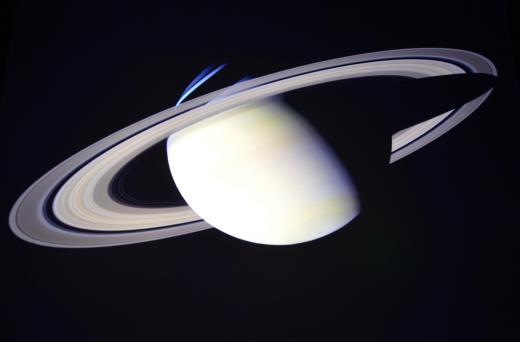What are Shepherd Moons?
 Mary McMahon
Mary McMahon
Shepherd moons are moons which literally shepherd the contents of a planetary ring, giving it a crisper edge and more definition. The presence of such satellites was suggested by researchers in the 1970s who were struggling to understand planetary rings and the variations in size, gaps, and structure which could be seen in high resolution photographs. Saturn, a planet famous for its ring, has several shepherd moons, and upon close examination, it is possible to see that the disc of material which surrounds the planet is actually composed of numerous rings, rather than a single solid body.
In a classic example, shepherd moons appear on either side of a planetary ring, although they can also appear on their own. The moon on the outside slows the particles in the ring, causing them to drop into a lower orbit. Outer moons push particles back into the ring, forcing the ring to have a clearly delineated border. If particles manage to push beyond this border, they end up being accreted onto the surface of the moon, thanks to its gravitational pull.

Inner moons, meanwhile, push particles away from themselves, and thereby into the ring. A typical pair of shepherd moons will be very close to each other at any given point in their orbit, which means that they tighten up the shape of the ring considerably by pushing in opposite directions, much like two people pushing against opposite ends of a stick will keep the stick in a more or less static position.
The two most notable shepherd moons of Saturn are probably Prometheus and Pandora, which shepherd the planet's F Ring, although the planet has many other moons and smaller shepherd satellites. The presence of so many orbiting objects around Saturn explains why the planet has so many rings, and why distinctive gaps of various sizes appear between some of these rings, as the shepherd satellites shove particles away from themselves, creating an area in which particles cannot orbit.
Numerous excellent photographs of Saturn and its shepherd moons can be found, illustrating the concept visually. This concept could have interesting potential applications for space exploration and settlement, as shepherd satellites can have a profound influence on the rings which surround some planets. Scientists could at some point take advantage of the forces created by shepherd moons to perform various activities in orbit, or to contribute to the development of artificial conditions which would be conducive to colonization of a planet.
AS FEATURED ON:
AS FEATURED ON:











Discussion Comments
How can they push?
just wondering about the the shepherd moons: Perhaps fallout of their own matter created the rings in the first place, and continued dynamics maintain it.
Never thought of this, but, normally, satellites orbit about the center of gravity of the host body. In the case of Saturn, for example, the "micro-satellites" orbit about the center axis, but in planes removed, "North" and "South" from the CG of Saturn.
Why haven't the orbits of moons and objects in the rings devolved into random orbits about the CG, thus creating a "shell" of orbiting matter and moons?
what if we earthlings make some shepherd satellites to herd all our space junk into nice neat rings so we can keep track of it?
Post your comments